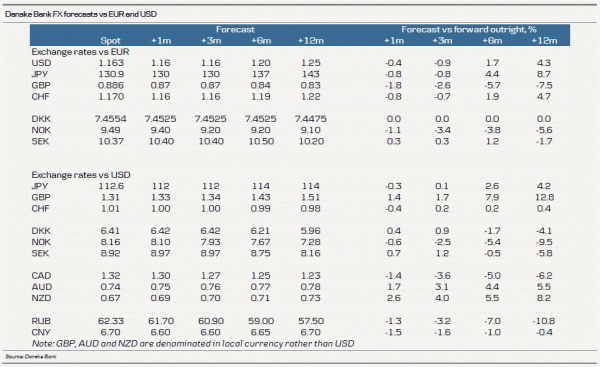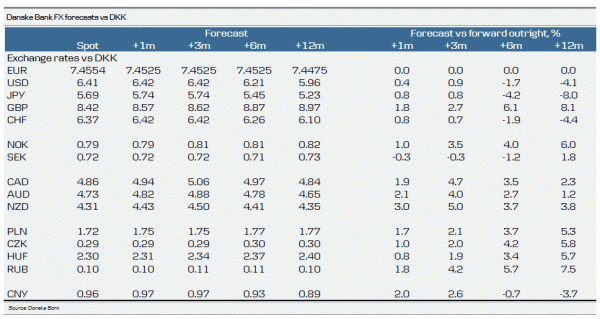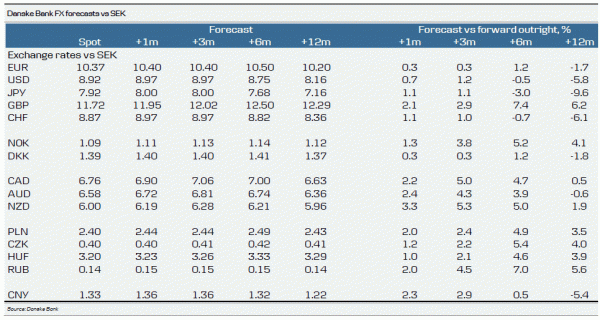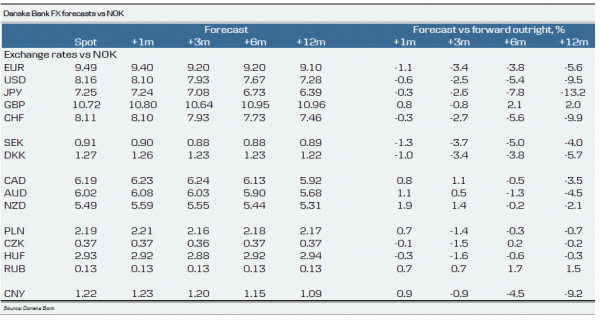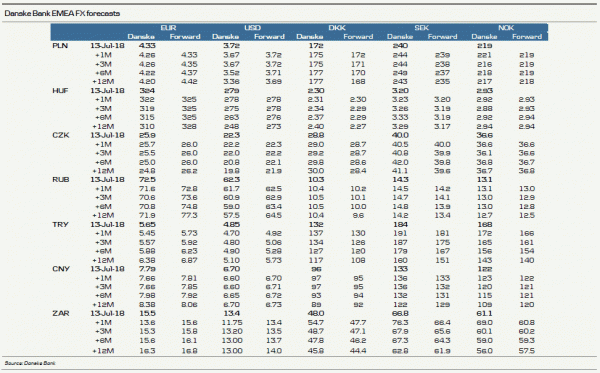Note this month’s FX Forecast Update is in shortened form
Majors. The trade war has returned as a key USD driver and, in our view, further escalation, which remains our base case, will tend to be USD supportive due to the less open US economy, which is set to lose less than those of its peers on a decrease in global trade. This said, recent Fed worries should keep a lid on USD strength but will also tend to make, notably, the ECB reluctant to commit to a tightening cycle.
EUR/NOK. At the June monetary policy meeting, Norges Bank confirmed market expectations of a September rate hike, which, in our view, marks an important fundamental trigger for the next move lower in EUR/NOK. In the very near term, the global environment of weaker growth and trade war fears alongside improved structural NOK liquidity and ‘summer trading’ should limit the short-term potential. We ‘roll’ our forecast profile to 9.40 in 1M (unchanged), 9.20 in 3M (9.30), 9.20 in 6M (9.30) and 9.10 in 12M (9.20).
EUR/SEK. We look for a wider range in EUR/SEK over the summer, which we addressed in a sold strangle recommendation (see Reading the Markets Sweden, 25 May). While we did argue for a temporary dip in EUR/SEK as inflation appeared set to meet and even breach the Riksbank’s expectations for a couple of months yet, this is not the case anymore. After the Riksbank raised its CPIF forecast in July, it effectively opened the door for inflation disappointments instead. We still think the Riksbank will postpone the first hike beyond 2018 and that this will weigh on the SEK later in H2. Hence, in a 3-6M perspective, the cross is primarily a buy on dips in our view. Apart from monetary policy, the slowing housing market domestically and the trade war globally are two other headwinds for the SEK. Cheap valuation fundamentally could be seen as a SEK-buying argument though for those with a longer term horizon. On balance, we set our 1M and 3M forecasts at 10.40 (previously 10.20), 6M to 10.50 (previously 10.40) and leave our 12M forecast at 10.20.
EUR/DKK. DKK is relatively more exposed to an escalation of the global trade as the Danish economy is small and very open and has significant exposure to global shipping. Furthermore, Denmark has net exposure to the stock market due to in particular the Danish Life and Pension (L&P) sector’s large holdings of US and euro-area stocks. This, in addition to the easier DKK liquidity situation, can help explain the recent rise in EUR/DKK above the 7.4500 level. In turn, we revise our EUR/DKK forecasts and now expect the pair to trade around 7.4525 in 1-6M buoyed by the factors above, before falling back to 7.4475 in 12M, as DKK remains well supported by strong fundamentals.
EUR/USD. We have made only minor changes to our forecast profile as we continue to see the negatives (trade war, carry appeal of USD, ECB on hold, Italy risks) dominating the longer term EUR positive impulses stemming from valuation and a turn in capital flows. Specifically, we expect EUR/USD to trade broadly within the 1.15-1.21 range over the next 6M period. However, our medium-term story remains unchanged: we believe the capital outflows of recent years will fade as we move closer to the first ECB hike. Alongside valuation, this is set to support EUR/USD in 6-12M. We see EUR/USD at 1.16 in 1M, 1.16 in 3M (previously 1.17), 1.20 in 6M (unchanged) and 1.25 in 12M (unchanged).
EUR/GBP. GBP has been in the hands of the Brexit-deal driven UK cabinet turmoil lately. For GBP, the rising risk of both a soft Brexit (GBP positive) and a ‘no-deal’ Brexit (GBP negative). We still expect the Bank of England to hike the Bank rate by 25bp to 0.75% in August. This is not fully priced in the market yet (put at 75% probability), so we expect relative interest rates to drive EUR/GBP slightly lower to 0.87 in 1M (previously 0.88). Longer term, we still expect EUR/GBP eventually to trade lower driven by Brexit clarifications and fundamental valuations. We continue to target EUR/GBP at 0.8650 in 3M, 0.84 in 6M and 0.83 in 12M.
USD/JPY. JPY weakness has materialised against USD and EUR despite rising trade concerns of late as the latter seems to currently affect the FX market mainly via economic (USD positive, JPY negative via its China exposure) rather than risk (JPY positive) channels. The recent level shift in USD/JPY has led us to revise higher our 1-3M forecasts to 112 in 1-3M (previously 110). That said, we stress that disregarding trade tensions, there are downside risks due to the lingering political uncertainty in Japan ahead of the Liberal Democratic Party’s (LDP) leadership election in September. Longer term, we expect USD/JPY to remain underpinned by Fed-Bank of Japan divergence and a continued move higher in US yields and now target USD/JPY at 114 in 6-12M (previously 112).
EUR/CHF. The SNB kept its dovish tone at the June meeting and maintained that the franc is ‘highly valued’ and kept the option of FX intervention open. While the SNB has clearly been challenged (again) by the ECB’s hesitant stance, the SNB should also have cemented its eagerness to see CHF weaker before making a shift on policy. With EUR strength set to return eventually, this makes us comfortable about maintaining a case for CHF depreciation in 6-12M but continued trade tensions is a downside EUR/CHF risk. We still look for 1.16 in 1M, 1.16 in 3M, 1.19 in 6M and 1.22 in 12M.
AUD, NZD, CAD. Trade war fears, weaker global growth and lower Chinese commodity demand all mark headwinds for the three commodity currencies. Meanwhile, Commodity Futures Trading Commission IMM positioning data already show that investors have turned very negative on the three, leaving an asymmetric balance of risk to positive news ahead. While the Bank of Canada looks set to hike rates an additional two times over the coming year, recent central bank communication, alongside weaker Chinese growth, has challenged our call of one 25bp rate hike from both the Reserve Bank of Australia (RBA) and the Reserve Bank of New Zealand (RBNZ). For now, we stick to our call but highlight risks are skewed towards unchanged policy rates in Australia and New Zealand over the next 12M. Fundamentally, CAD seems undervalued whereas AUD and NZD seem closer to fair value (versus USD). We leave our forecast profiles unchanged for all three currencies.
Emerging markets. Emerging market currencies are set to remain challenged by the risk of an escalating trade war, lower commodity prices and a stronger USD near term and rising US rates and tighter US liquidity over the medium term. Notably, TRY has suffered driven by political developments but otherwise we see the risk of a contagious sell-off as limited, as the likelihood of significant further USD strength is small after all. With the ECB effectively on hold and wage-price pressure mounting in, notably, Eastern Europe, these currencies in particular should stay supported vis-à-vis the EUR near term.
EUR/CZK. Despite the June CNB hike, EUR/CZK continues to trade around 25.90 and we project the cross to continue to hover around current levels in the short term. In the medium term, we expect the CZK to return to its moderate strengthening path, as the Czech macroeconomic backdrop remains very favourable and the CNB is likely to deliver its next interest rate hike within the coming months. This said, we expect the depreciation pace to abate compared with 2017, as the Czech economy shifts into a lower gear and the ECB is also gradually moving towards policy normalisation. We leave our forecasts for EUR/CZK unchanged at 25.70 in 1M, 25.50 in 3M, 25.00 in 6M and 24.80 in 12M.
EUR/HUF. The CEE currencies are among the most exposed emerging market currencies to escalating trade wars globally, with the HUF remaining the most exposed of the CEE currencies. While we believe that a stronger EUR and more hawkish Hungarian central bank will help the HUF, escalating trade wars remain the major risk for the currency. Given the dominating uncertainty, we update our EUR/HUF forecasts as follows: 322 in 1M (previously 315), 319 in 3M (previously 311), 315 in 6M (previously 308) and 310 in 12M (previously 305).
USD/RUB. The rouble continues its journey detached from the crude price, driven mostly by the global emerging market sentiment on the trade war and geopolitical cautiousness; notably, Russia’s Ministry of Finance is set to continue limiting the RUB’s extra strengthening on oil price swings. Still, a lower oil price would be RUB negative. The revived hawkishness of the Bank of Russia is helping the RUB among other emerging markets. Given the current escalation of global trade wars, we see the USD/RUB pair staying higher from our previous forecasts but lower still over the forecast horizon: 61.70 in 1M (previously 61.50), 60.90 in 3M (previously 60.10), 59.00 in 6M (previously 58.30) and 57.50 in 12M (previously 55.70).
USD/TRY. The Turkish lira has entered another perfect storm, as shaky macro fundamentals are eroded by the high oil price, weak emerging market sentiment and the returning personal grip of President Recep Erdoğan on the economic processes, TRY and monetary policy. The markets continue to dislike this kind of interference, now pricing extremely high TRY hedging. We expect the TRY sell-off to calm down, if the President announces a fiscal austerity programme and signals more central bank independency. We expect the USD/TRY to slide down slightly from the current levels in the near term, updating the forecast as following: 4.70 in 1M (previously 4.40), 4.80 in 3M (previously 4.45), 4.90 in 6M (previously 4.35) and 5.10 in 12M (previously 4.50).
USD/CNY. Mounting trade tensions between the US and China have put downward pressure on the CNY and the risk of continued CNY weakness remains. China is more vulnerable than the US in the short term, as its economy is already weakening and China is more dependent on exports, while the US enjoys fiscal support and is a more closed economy. We expect pressure on the Chinese economy to lead to further easing by the People’s Bank of China and emphasise the risk of outflows also picking up, supporting the case for a weaker CNY. In FX Strategy – Downward revision to our CNY outlook (26 June), we revised our USD/CNY and EUR/CNY forecasts higher to target USD/CNY at 6.70 in 12M and EUR/CNY at 8.38 in 12M. While we maintain these here, we stress that risks remain skewed towards a significantly weaker CNY than incorporated in our forecasts.




